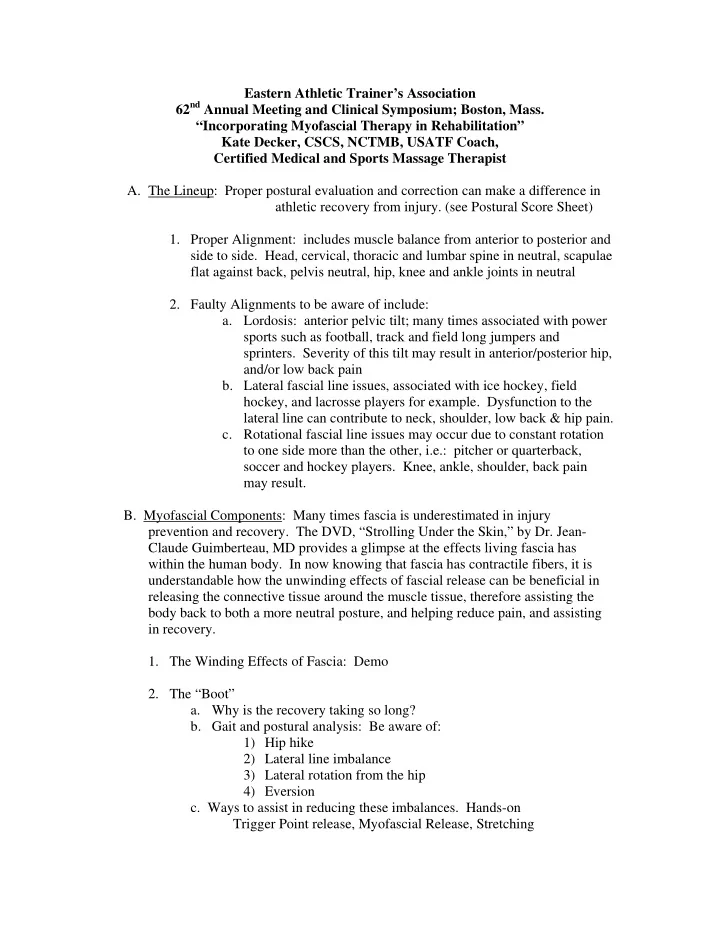

Eastern Athletic Trainer’s Association 62 nd Annual Meeting and Clinical Symposium; Boston, Mass. “Incorporating Myofascial Therapy in Rehabilitation” Kate Decker, CSCS, NCTMB, USATF Coach, Certified Medical and Sports Massage Therapist A. The Lineup: Proper postural evaluation and correction can make a difference in athletic recovery from injury. (see Postural Score Sheet) 1. Proper Alignment: includes muscle balance from anterior to posterior and side to side. Head, cervical, thoracic and lumbar spine in neutral, scapulae flat against back, pelvis neutral, hip, knee and ankle joints in neutral 2. Faulty Alignments to be aware of include: a. Lordosis: anterior pelvic tilt; many times associated with power sports such as football, track and field long jumpers and sprinters. Severity of this tilt may result in anterior/posterior hip, and/or low back pain b. Lateral fascial line issues, associated with ice hockey, field hockey, and lacrosse players for example. Dysfunction to the lateral line can contribute to neck, shoulder, low back & hip pain. c. Rotational fascial line issues may occur due to constant rotation to one side more than the other, i.e.: pitcher or quarterback, soccer and hockey players. Knee, ankle, shoulder, back pain may result. B. Myofascial Components: Many times fascia is underestimated in injury prevention and recovery. The DVD, “Strolling Under the Skin,” by Dr. Jean- Claude Guimberteau, MD provides a glimpse at the effects living fascia has within the human body. In now knowing that fascia has contractile fibers, it is understandable how the unwinding effects of fascial release can be beneficial in releasing the connective tissue around the muscle tissue, therefore assisting the body back to both a more neutral posture, and helping reduce pain, and assisting in recovery. 1. The Winding Effects of Fascia: Demo 2. The “Boot” a. Why is the recovery taking so long? b. Gait and postural analysis: Be aware of: 1) Hip hike 2) Lateral line imbalance 3) Lateral rotation from the hip 4) Eversion c. Ways to assist in reducing these imbalances. Hands-on Trigger Point release, Myofascial Release, Stretching
B. The Protracted, Medially Rotated Shoulder: Sports involved: football, swimming, basketball, hockey, baseball, soccer goalie, lacrosse Other contributing factors: prolonged…texting, computer work, playing video games. 1. Having this shoulder position can be associated with neural, shoulder, neck, mid back and chest pain. 2. Reducing this postural position through: myofascial release, trigger point therapy, stretching. Hands-on C. Protect Yourself at All Times: It is easy after having a long day, week or season to forget proper biomechanics while working with athletes, but it’s important to keep yourself safe and injury free. 1. Proper “lifting position” helps while working with athletes of most any size, i.e.. Flat back, eyes straight. 2. While using trigger point release or myofascial release technique making sure you are using a table with proper height and keeping your fingers, wrists, elbows and shoulders so that you are bone on bone as well as staying behind your stroke will help, too. D. Books To Help: 1. “Myofascial Pain and Dysfunction,” by David G. Simons, MD and Janet Travell, MD 2. “Muscle Testing and Function,” by Florence Peterson Kendall, PT and Elizabeth Kendall McCreary. 3. “Clinical Massage Therapy,” by Fiona Rattray and Linda Ludwig 4. “Anatomy Trains,” by Thomas W. Myers
Recommend
More recommend